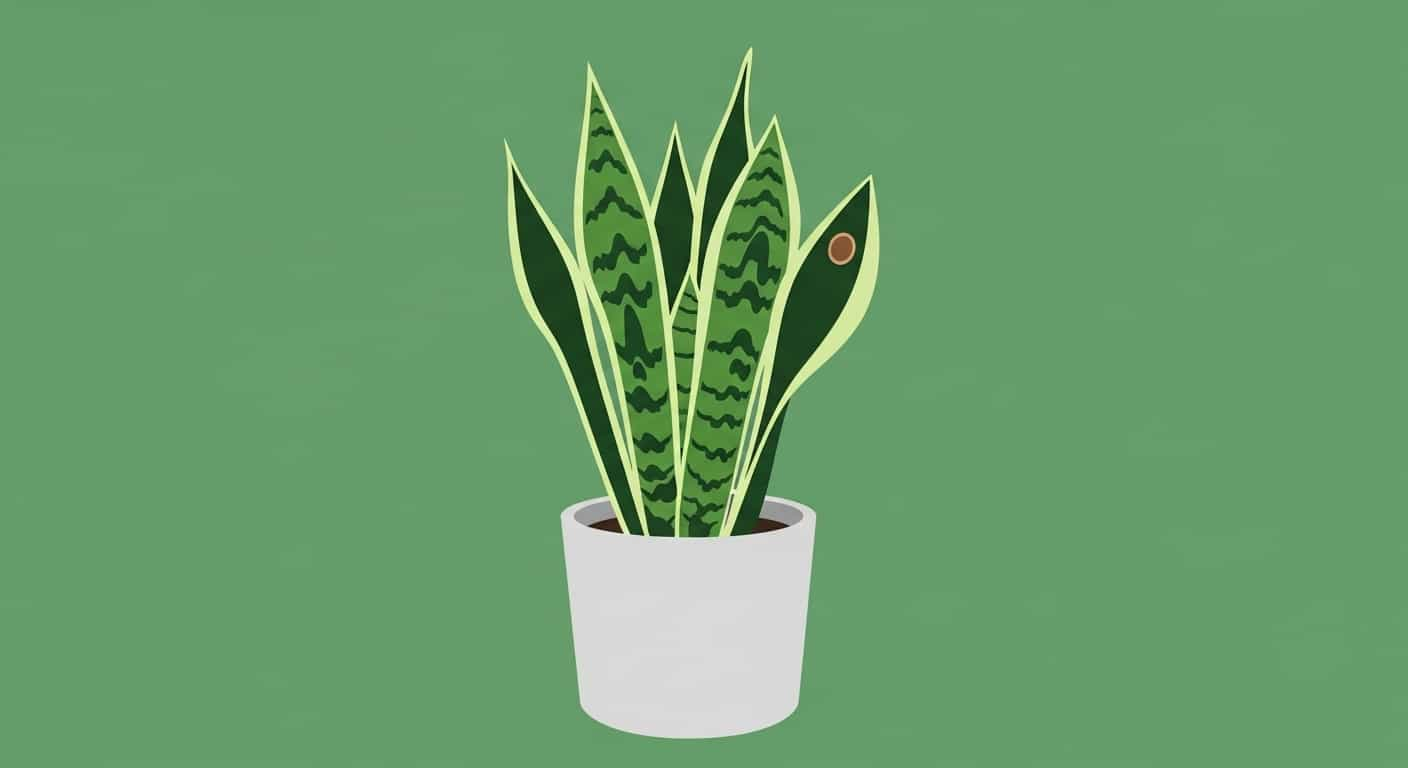Snake plants are celebrated for their resilience and easy-going nature, making them a favorite for both new and experienced plant parents. So, when you notice unsightly brown spots on your snake plant, it’s natural to feel a pang of concern. These blemishes can disrupt the plant’s sleek, architectural look and signal that something is amiss with its health. But don’t panic—identifying the cause is the first step toward nursing your plant back to perfection.
Finding snake plant brown spots is a common issue, and in most cases, it’s easily correctable. These spots can range from small, dry patches to large, mushy lesions, and each type tells a different story about what your plant needs.
This in-depth guide will help you become a plant detective. We’ll explore the various reasons your snake plant might be developing brown spots, from simple watering mistakes to more serious fungal issues. You’ll learn how to diagnose the problem accurately and apply the right fix to restore your plant’s health and prevent future blemishes.
Uncovering the Culprits: Common Causes of Brown Spots
Brown spots on snake plant leaves are symptoms, not the disease itself. They are the plant’s way of telling you that it’s unhappy with its environment or care routine. Let’s break down the most common culprits.
1. Fungal Infections and Diseases
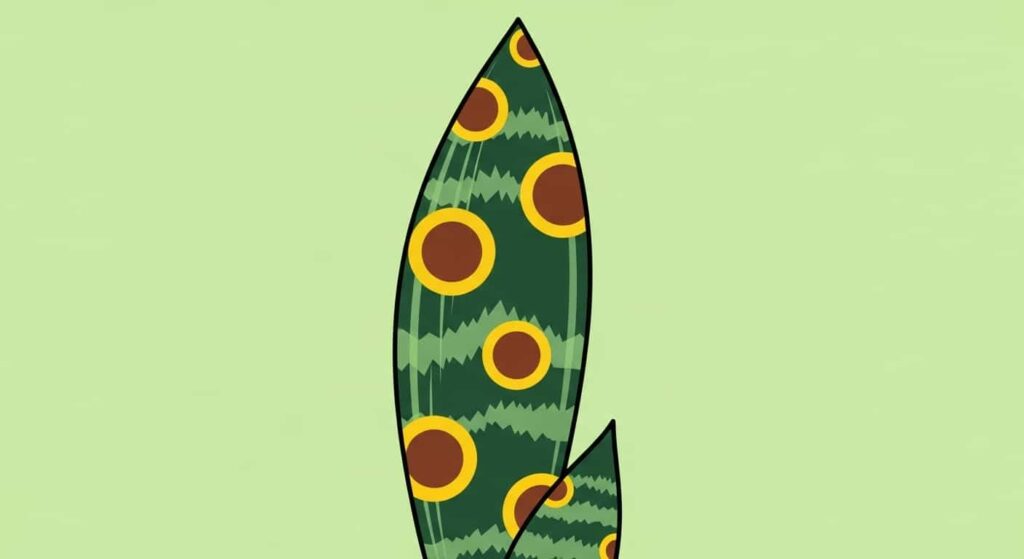
Fungal problems are a primary cause of distinct, often spreading, brown spots. These infections thrive in damp, humid conditions and can take hold if the leaves stay wet for too long or if there’s poor air circulation.
- Fungal Leaf Spot: This condition typically appears as dark brown or reddish-brown spots with a yellow halo around the edges. The spots may start small but can grow and merge over time. If left untreated, the affected leaves may eventually wither and die. This is a classic case of snake plant browning caused by a pathogen.
- Southern Blight: A more aggressive fungal disease, Southern Blight causes mushy, water-soaked brown lesions at the base of the plant, right at the soil line. You might also see white, fan-like fungal growth (mycelia) on the soil surface. This is a serious issue that can quickly lead to rot and plant death.
2. Overwatering and Root Rot
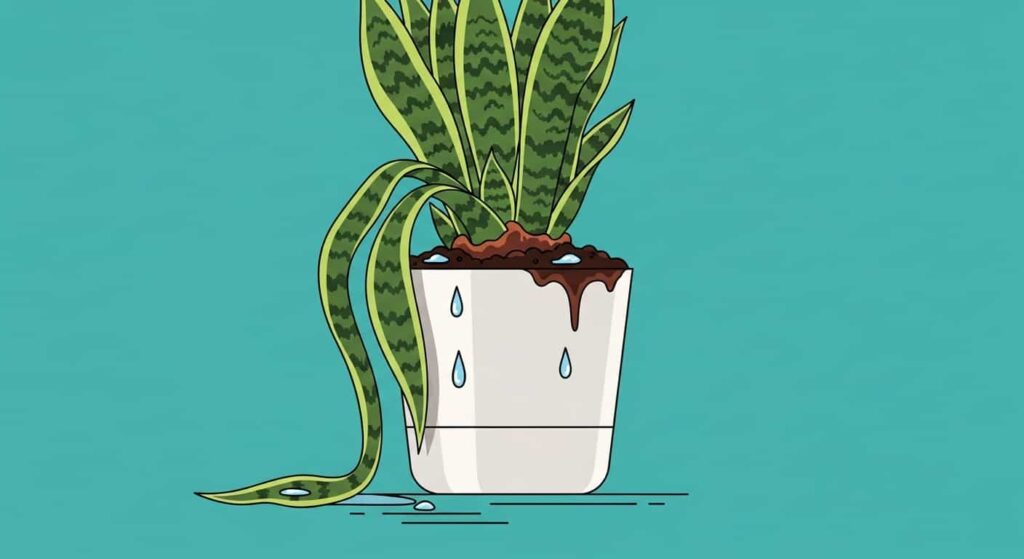
Overwatering is perhaps the most frequent mistake made by snake plant owners. These succulent-like plants are adapted to arid conditions and are extremely susceptible to root rot if their soil stays too wet.
When the roots drown from a lack of oxygen, they begin to decay. These unhealthy roots can no longer absorb water and nutrients, causing the plant to show signs of distress. This often manifests as soft, mushy snake plant brown leaves or large, dark brown patches that start from the base and move upward. If you notice a foul smell coming from the soil, root rot is almost certainly the issue.
3. Pest Infestations
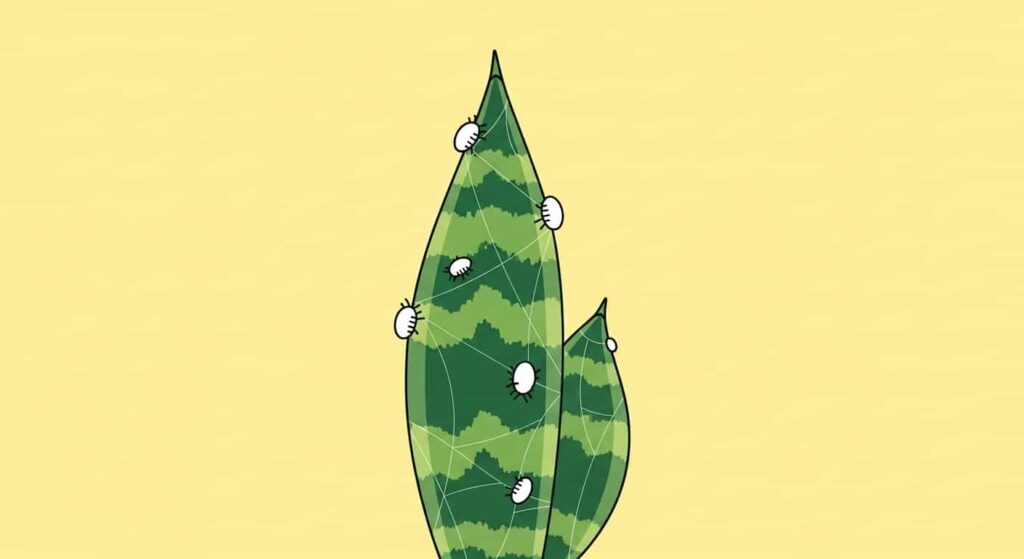
While snake plants are quite pest-resistant, they are not entirely immune. Sap-sucking insects can cause damage that appears as small, brown, or yellow spots on the leaves.
- Mealybugs: These tiny, white, cottony insects cluster in the crevices of the leaves and at the base of the plant. They feed on the plant’s sap, leaving behind yellow or brown spots and a sticky residue called honeydew.
- Spider Mites: These minuscule pests are hard to see with the naked eye, but you can spot their fine, web-like material between the leaves. They cause stippling damage, which looks like a collection of tiny yellow or brown spots on snake plant leaves.
- Thrips: Thrips can cause silvery or brown patches on leaves where they have scraped away the surface to feed.
4. Physical Damage and Environmental Stress
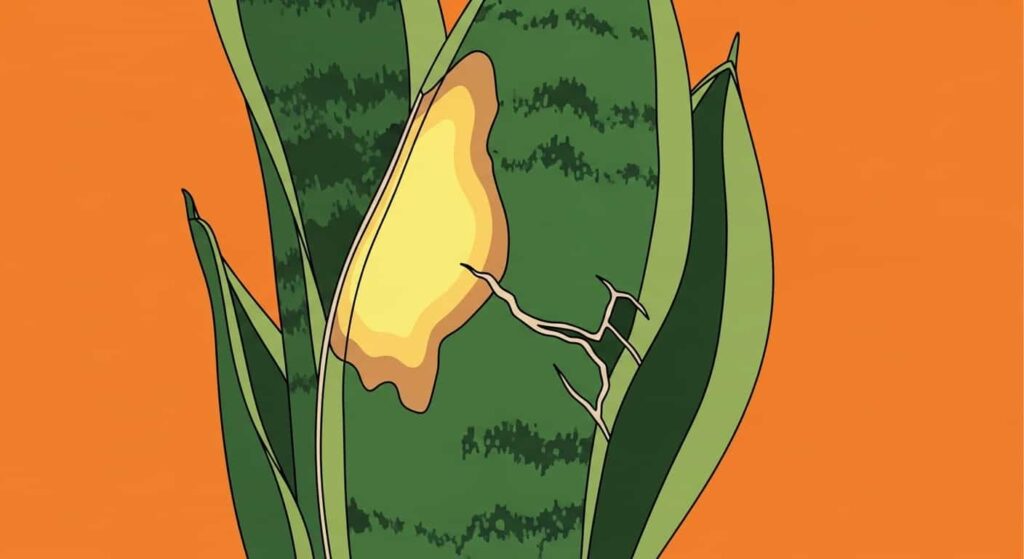
Sometimes, the cause is purely mechanical or environmental.
- Sunburn: Although snake plants appreciate bright, indirect light, exposing them to harsh, direct sunlight can scorch their leaves. Sunburn appears as bleached, whitish-yellow spots that eventually turn into dry, snake plant brown tips or patches.
- Low Humidity: While snake plants don’t need high humidity, extremely dry air can cause the tips of snake plant leaves to turn brown and crispy. This is a common issue in heated homes during the winter.
- Mechanical Damage: A simple bump, scratch, or fold in a leaf can create a wound. The plant will naturally seal off this damaged area, which often results in a dry, brown scar.
5. Underwatering
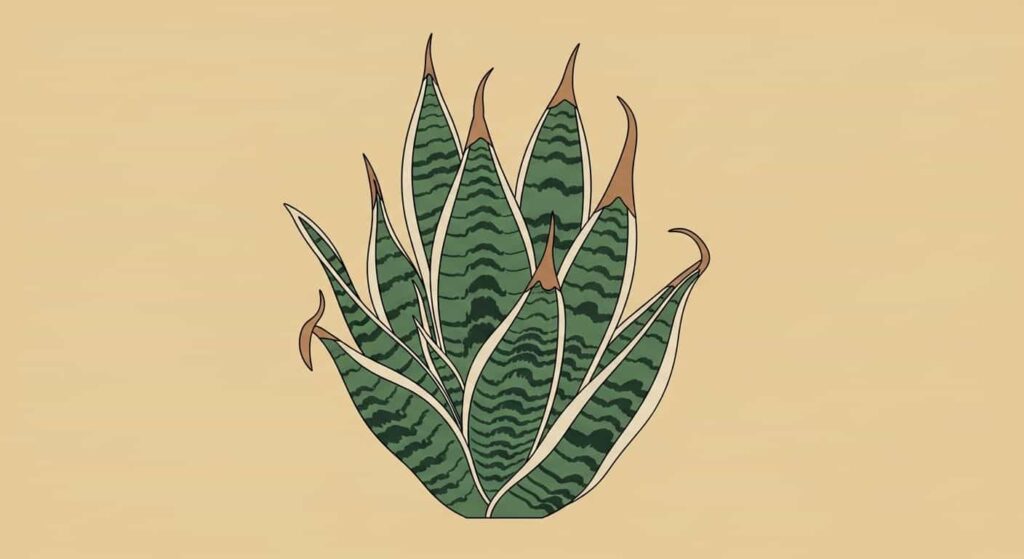
It might seem counterintuitive given their drought tolerance, but prolonged underwatering can also cause problems. If a snake plant goes without water for too long, its leaves may start to wrinkle, and the tips will dry out and turn brown. The snake plant leaves turning brown from lack of water will typically feel dry and brittle.
Playing Detective: How to Diagnose the Problem
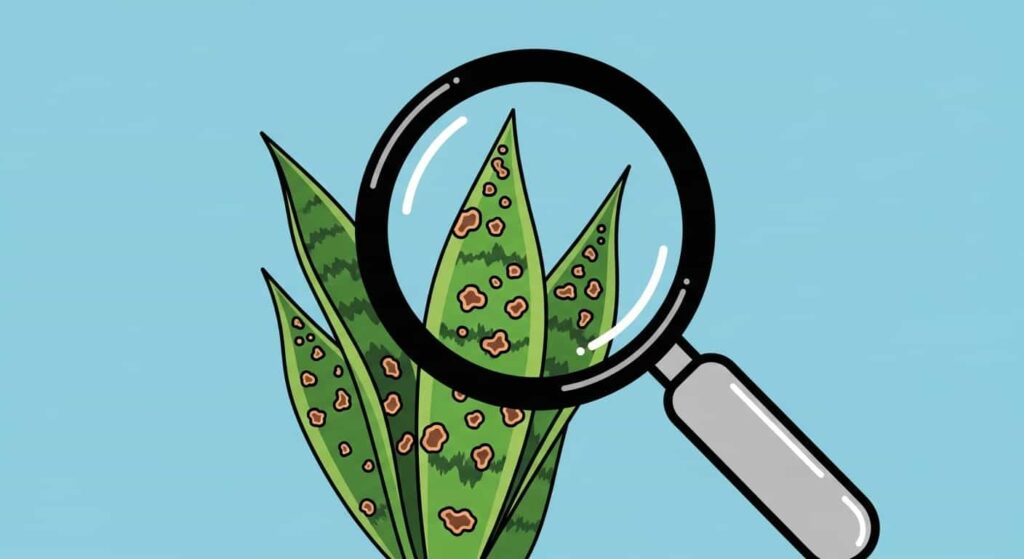
To find the right solution, you need to correctly identify the cause. Use this checklist to examine your plant and its environment.
- Examine the Spots:
- Are the spots soft and mushy? This points to overwatering or fungal blight.
- Are they dry and crispy, especially at the tips? Consider underwatering, low humidity, or sunburn.
- Do the spots have a yellow halo? This is a classic sign of a fungal leaf spot.
- Are they small and numerous? Inspect closely for pests like spider mites.
- Check the Soil and Roots:
- Stick your finger two inches into the soil. Is it wet? If so, overwatering is a likely suspect.
- Gently slide the plant out of its pot. Are the roots white and firm (healthy) or dark, mushy, and smelly (rotted)?
- Inspect for Pests:
- Look closely at the leaf joints and undersides. Do you see any tiny insects, white fluffy masses, or fine webbing?
- Consider the Location:
- Is the plant sitting in direct, intense sunlight? Sunburn could be the cause.
- Is it near a heating vent or radiator? Low humidity might be drying out the leaf tips.
Step-by-Step Solutions and Fixes
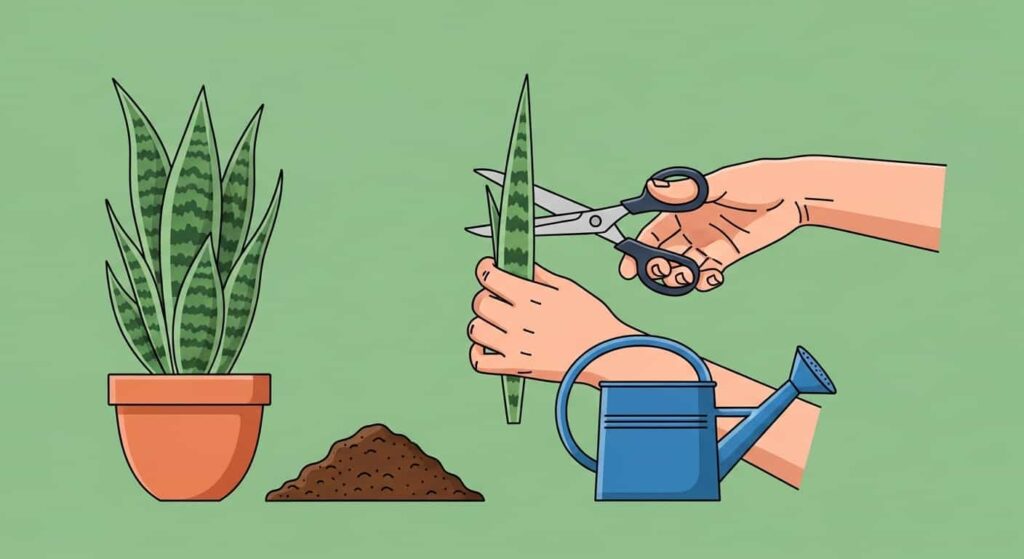
Once you’ve diagnosed the problem, you can take action.
For Fungal Infections:
- Isolate the Plant: Immediately move the infected plant away from others to prevent the spread of fungal spores.
- Prune Infected Leaves: Use a sterilized pair of scissors or pruning shears to remove any leaves with significant spotting. For minor spots, you can try to cut out just the brown area, but removing the whole leaf is safer.
- Improve Air Circulation: Ensure there is good airflow around the plant. Don’t crowd your plants too closely together.
- Apply a Fungicide: For persistent infections, treat the plant with a copper-based or sulfur-based fungicide. Follow the product instructions carefully.
For Overwatering and Root Rot:
- Remove the Plant: Carefully take the snake plant out of its pot and gently shake off the old, waterlogged soil.
- Inspect and Trim the Roots: Examine the root system. Using sterile scissors, trim away all black, mushy, or smelly roots. Healthy roots are firm and typically white or light orange.
- Repot in Fresh Soil: Repot the plant in a new pot with excellent drainage holes, using a fresh, well-draining potting mix designed for cacti or succulents.
- Water Sparingly: Do not water the newly repotted plant for at least a week to allow the cut roots to heal. Then, adopt a more conservative watering schedule, allowing the soil to dry out completely between waterings.
For Pest Infestations:
- Wipe Away Pests: For mealybugs and spider mites, dab a cotton swab in rubbing alcohol and wipe the pests off the leaves.
- Rinse the Plant: Give the plant a gentle shower with lukewarm water to dislodge any remaining pests.
- Apply an Insecticide: For heavier infestations, spray the plant with neem oil or an insecticidal soap. Be sure to coat the entire plant, including the undersides of the leaves. Repeat the treatment every 7-10 days until the pests are gone.
For Environmental Stress:
- Adjust Lighting: If sunburn is the issue, move the plant to a location where it receives bright but indirect light. An east-facing window is often ideal.
- Increase Humidity: If you have snake plant brown tips from dry air, try grouping plants, using a pebble tray with water, or placing a small humidifier nearby.
- Handle with Care: Place your plant in a low-traffic area to avoid accidental bumps and scratches.
Prevention: The Best Medicine for Your Snake Plant

Keeping brown spots at bay is easier than treating them. Follow these preventative tips to keep your snake plant healthy and beautiful.
- Water Correctly: The golden rule for snake plants is to water thoroughly but infrequently. Wait until the soil is completely dry before watering again.
- Ensure Proper Drainage: Use a pot with drainage holes and a gritty, well-aerating soil mix.
- Provide Appropriate Light: Give your plant plenty of bright, indirect sunlight.
- Inspect Regularly: Make it a habit to check your plant for any early signs of pests or disease during your watering routine.
A Healthy Plant is a Happy Plant
Noticing brown spots on your snake plant can be disheartening, but it’s a valuable learning opportunity. By carefully observing your plant and understanding its needs, you can quickly diagnose the issue and take the necessary steps to fix it. With proper watering, the right amount of light, and regular inspections, your snake plant will thrive, rewarding you with its enduring beauty for years to come.
Frequently Asked Questions
Can a brown spot on a snake plant heal or turn green again?
No, once a part of the leaf turns brown, it will not revert to green. The damage is permanent. The best course of action is to address the underlying cause to prevent more spots from forming.
Should I cut off leaves with brown spots?
If a leaf has just a small brown leaf tip, you can simply trim off the brown part with clean scissors. If a leaf is heavily spotted or damaged by rot, it’s best to prune the entire leaf at its base. This will improve the plant’s appearance and redirect energy to healthy growth.
How do I know if my snake plant is getting too much light?
Besides brown scorch marks, signs of too much light include leaves that look faded, washed-out, or yellowish. The leaves may also start to curl inwards.

